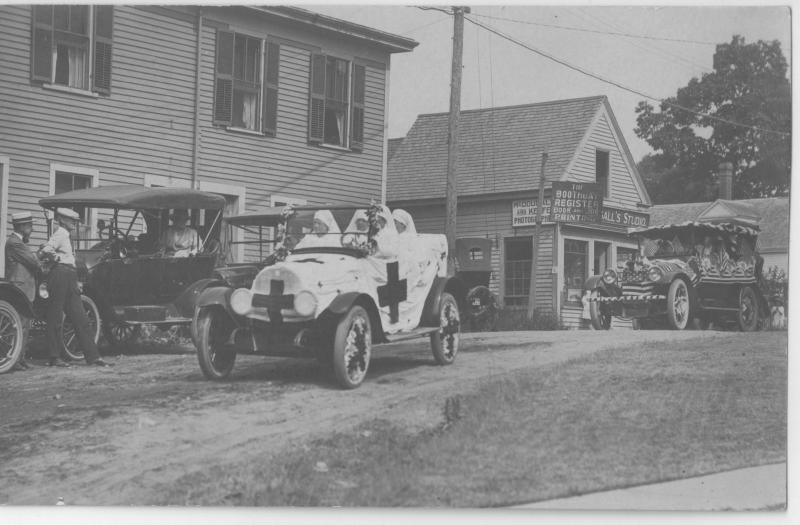Struggling with change in the 1920s, part I

Boothbay and Boothbay Harbor were really struggling with the modern era in the 1920s. Cars and trucks, though still relative rarities here, were inexorably supplanting beasts of burden and waterborne transportation, resulting in major fights at town meeting. Many couldn't believe the age-old conditions they and their forebears had experienced would become quaint instead of moving with them into the future. Nor did many believe it was worth the expense to support the novelty of motorized transport.
Horses versus cars
But the times were changing fast and had been for some time. By 1916, the Good Roads League was formed to militate for road improvements to defeat mud and handle deep snow. That year there were 21 cars taxed in Boothbay. A 1916 parade of 30 cars to promote good roads was such a spectacular sight — seeing so many at once — that people gathered along the route, as some do now for antique cars. Of course the parade occurred before the roads became impassable. Plowing in the winter to allow year-round driving was a radical idea, as was surfacing roads that turned to mud. Beyond a certain manageable point, letting mud and snow reign supreme was the time-honored way. Horses could handle conditions too severe for cars, but if too rough for horses, residents just waited until conditions improved, or, sometimes, if possible, took to higher ground through private property. The Edgecomb hill, and some in Boothbay and the Harbor, stopped just about everything not powered by horses in severe mud or snow.
Even in the 1960s, coming from East Boothbay toward the Harbor, we'd pause at the top of the big hills (they were higher then) to gauge if there was too much snow or too many cars off the road to make it down to the bottom and back up the other side. Just as there was a horse team stationed on the Edgecomb hill in the 1920s to haul cars out of snowbanks, high school boys, like Philip Gregory in his Scout, at times stationed themselves at the big hills in the 1960s to do likewise. Lengths of chain and snow chains were still standard gear in the trunk.
Whether to nurture or limit motorized travel was the obsession in the 1910s and right up through the 1920s. I heard that grown men often didn't learn the drive, relying on their sons who'd been born at the advent of cars to do the driving. And many men and women I knew who drove horses in the 1910s and 1920s had countless stories of horses' panic-stricken reaction to their first few cars. Other local older men who learned to drive didn't learn to steer well, too used to a lifetime of relying on horses being guided by their eyes. Cars deferred to horses into the 1920s; then the switch came as cars became dominant, and horses gave way.
Plowing for motorized vehicles
The controversy over plowing in winter caused friction state-wide and at town meeting. Those used to waiting didn't know what the hurry was all about. But the hurried age was on the doorstep for all — proponents and opponents alike. In early 1925 the state Highway Commission announced for the first time it would try to keep the road open — fight the snow — between Bath and Rockland throughout the winter.
Over and over from 1919 to 1926 the townspeople in the Harbor and Boothbay turned down articles to get a town plow or to keep the roads open all winter. Halfway measures of the town renting a plow from tractor suppliers, with the hope of purchase a few months later as people saw the advantages, ended with refusal for years. At a 1926 Harbor town meeting, an out-of-town tractor salesman couldn't get unanimous consent to give his pitch to the residents. Town officials resorted to the stratagem of adjourning the meeting for half an hour to allow him time to speak to those present. It was still voted down, but a few residents stepped in, bought the plow, and rented it to the town. At the next town meeting, it was finally voted to buy it.
Boothbay hoped to rent the Harbor's plow in 1926 but finally gave in and bought a plow in 1927. I remember the town's first V-plow and horse-drawn grader in the 1990s where they rested in retirement up on Giles Hill. Once the first plow was bought, there was pressure for more as all parts of town wanted attention for their many more miles of far-flung roads. The same Boothbay-and-Harbor pattern of resistance was true of adopting tarred roads. The Harbor's first was 1926; Boothbay's was 1927. Those years were the last hurrah for sizable opposition to spending taxpayer money to benefit newfangled cars and trucks.
Next time: Boothbay Harbor's proposed waterfront road at the 1926 town meeting.






























